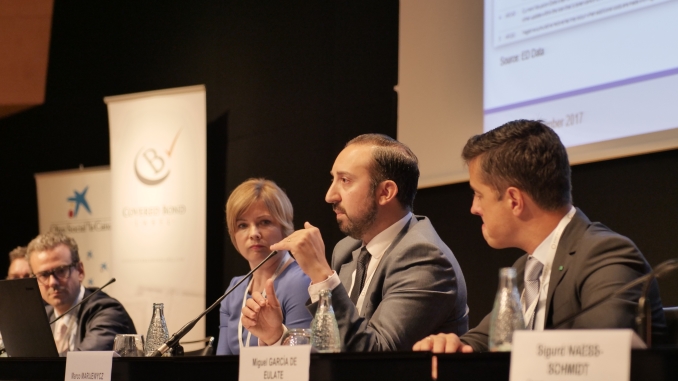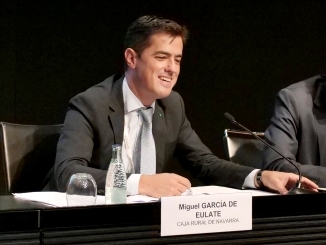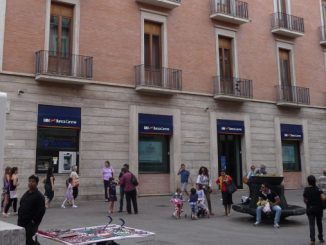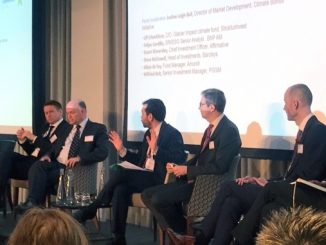
The EMF-ECBC is hoping to gain European Commission support and funding for developing a data protocol that would help optimise its energy efficient mortgages initiative, although a speaker at a plenary meeting of the industry body warned that “the best is the enemy of the good”.
A consortium led by the European Mortgage Federation-European Covered Bond Council won similar support from the Commission for its mortgage initiative earlier this year and in June kicked off the Energy efficient Mortgages Action Plan (EeMAP). This is targeting an energy efficient mortgage product that would incentivise the purchase of energy efficient properties or facilitate energy efficiency improvements in existing properties, tied to the argument that such loans represent a lower risk to lenders. It could also boost the volume of green collateral that would be available to back funding through covered bonds, for example.
Chairing a panel of consortium members and specialists at a 13 September ECBC plenary in Barcelona, Jennifer Johnson, head of economic and legal affairs at the EMF-ECBC, noted that a recurring challenge that arises in discussions around the project is a lack of relevant data relating to mortgages. The consortium has therefore applied to the Commission for further funding for a complementary project, the Energy efficiency Data Portal & Protocol (EeDaPP).
“EeDaPP is about delivering a standardised data protocol to be accessed by way of a centralised portal,” said Johnson.
Marco Angheben, director, business development, European DataWarehouse, which collects ABS loan level data and documentation, said that such a protocol is absolutely necessary in order to proceed with collating data. He also noted that green information is increasingly being considered to be included in regulation, citing STS (simple, transparent and standardised) securitisation templates that are set to be drawn up by ESMA.
“It’s going to be particularly interesting because we already collect a lot of information about residential properties that are securitised, but we would be very keen on collecting additional information regarding, for example, how energy efficient is the house,” he said.
European DataWarehouse already records some green information relating to the first green RMBS, from the Netherlands’ Obvion.
“What does it mean, ‘green’, in this case? Well, it means certain houses in the Netherlands selected by the originator according to the country-specific energy efficient scale as indicated in the prospectus,” said Angheben. “But exactly what green means and what energy efficiency means, this is going to be the devil in the detail – that’s exactly what needs to be in the protocol.
“And I think we have a great challenge ahead because there is a great interest from all across in terms of collecting the data and then disseminating it to a wider audience.”
A three-step approach is envisaged, according to Johnson: collecting information; processing that information; and then disclosing it.
Torsten Schmidt, managing director, TXS – which produces software solutions for covered bond and securitisation transactions, said that in the first step, relating to the uploading and validating of data, the information supplied will be according to relevant national circumstances.
“The impetus behind this is, first, to get as soon as possible to launch, get the data, and begin the learning process of this infrastructure with a reduced complexity,” he said. “And, second, it is to gather information as it is – raw data without any transformation or reduction of content – otherwise its meaning could get lost if it is transformed at too early a stage in the project.”
Schmidt meanwhile suggested that Blockchain could have a role to play in the infrastructure.
“An idea to be discussed, for example, is to use distributed ledger technology – well known as Blockchain, to implement a Europe-wide green mortgage registry,” he said. “Green mortgages could be easily registered, certified as green. This could be the backbone of this green mortgage ecosystem.”
Marco Marijewycz, team leader, technology policy and modelling at E.ON, noted how energy efficiency data – for example, from smart meters – could be valuable to both customers/borrowers and lenders. And he said that there are precedents available for the kind of information EeDAP will be dealing with.
“One of the other consortium partners in EeMAP is the World Green Building Council and the Europe Regional Network, and what they bring to the table is an understanding of the raft of existing national standards and building codes that exist, which can be pointed at to say, that’s a good building, refurbishing to that standard is a good outcome,” said Marijewycz (pictured, speaking, in main photo). “And this is where EeMAP is in the position to almost make a market, build a brand that customers can trust, but also that those in the world of finance are able to trust as well because it’s built on substance.
“This is where labelling has a clear role to play,” he added, “and the stuff is out there – we just need to connect it all together.”
Miguel García de Eulate, head of treasury and capital markets at Caja Rural de Navarra (pictured), highlighted the value of energy efficient mortgage data when he said that a lack of such information had prevented the Spanish cooperative bank from including residential mortgages as assets for use-of-proceeds sustainable senior and covered bond issuance.

But he quoted the aphorism, “the best is the enemy of the good”.
“My fear is that if we try to find something which is too demanding to begin with, we probably risk getting stuck at the beginning,” said García de Eulate. “That is not to say that we don’t need something that is reliable enough, but we need to proceed with something.
“We need an approach that takes into account that really most of the banks participating in the EeMAP project still have no integrated information in our IT systems concerning the energy efficiency of the residential mortgages.”
Johnson said the EMF-ECBC should hear whether it will receive support for EeDAPP by the beginning of November.
“I’m hoping that we’re not a one-hit wonder,” she said, “and that actually we can manage to bring this one home as well.”
Photos credit: EMF-ECBC



